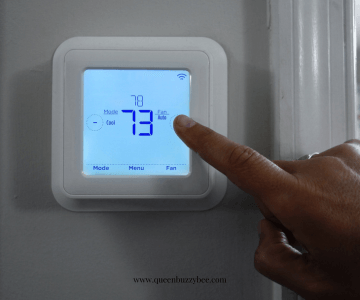How to Cut Utility Costs by 20% This Winter: Easy Tips to Keep Warm Without Breaking the Bank
This post may contain affiliate links, if you buy a suggested product I will earn a small commission. We are a participant in the Amazon Services LLC Associates Program, an affiliate advertising program designed to provide a means for us to earn fees by linking to Amazon.com and affiliated sites.” Read the full disclosure policy here.
Winter can be a beautiful season, but it also brings with it higher utility bills as we try to keep our homes warm and cozy. The good news is that you don’t have to sacrifice comfort to save money on your energy bill. By making a few smart changes, you can easily reduce your utility costs by up to 20% this winter.
Here are some simple and effective tips to help you cut down on your energy usage while still staying warm.
Seal Drafts and Insulate Your Home
One of the biggest causes of high heating bills is drafts from windows, doors, and poorly insulated areas of your home. Cold air can seep in through gaps and cracks, making your heating system work harder to maintain a comfortable temperature. The solution? Seal those drafts and improve your insulation.
- Use weatherstripping around doors and windows to keep cold air out.
- Add caulking to seal cracks in walls or around window frames.
- If your home lacks insulation, consider adding insulation to your attic or walls to keep heat from escaping.
These small changes can make a huge difference in your home’s energy efficiency and significantly lower your heating costs.
Lower Your Thermostat by a Few Degrees
You don’t need to keep your home as warm as a tropical island to stay comfortable in the winter. Lowering your thermostat by just 2-3 degrees can save you up to 10% on your heating bill each year. You’ll still feel cozy, especially if you layer up with warm clothing and blankets.
For even more savings, consider using a programmable thermostat. These devices automatically adjust the temperature based on your schedule. You can set it to lower the heat while you’re asleep or away from home, saving energy when it’s not needed.
Bonus Tip: A smart thermostat can be controlled remotely, allowing you to adjust the temperature even when you're not home!

Use Energy-Efficient Space Heaters
Instead of heating your entire home, consider using energy-efficient space heaters to warm only the rooms you’re using. Space heaters are a great way to save money, especially if you spend most of your time in just a couple of rooms.
When using a space heater, make sure to choose one that is energy-efficient and has built-in safety features like an automatic shut-off. Use the space heater wisely by turning it off when you leave the room or go to bed.
Pro Tip: Close the doors to rooms you’re not using to keep the heat where you need it most.
Take Advantage of Natural Sunlight
Even in the winter, the sun can be your ally in cutting down heating costs. Open your curtains and blinds during the day to let the sunlight naturally warm your home. Sunlight streaming through windows can provide free heat, so take advantage of it as much as possible.
Once the sun sets, close your curtains or blinds to keep the heat inside and prevent cold drafts from sneaking through your windows.
Perform Regular Maintenance on Your Heating System
A well-maintained heating system runs more efficiently, which can help you save money on energy costs. Make sure to perform regular maintenance on your furnace or heating system to keep it running smoothly.
- Replace or clean your air filters every 1-3 months to ensure proper airflow.
- Schedule an annual HVAC checkup with a professional to make sure your system is working efficiently and there are no issues.
- Check your ductwork for leaks, which can cause heat to escape before it reaches your living space.
Taking care of your heating system ensures that it works efficiently and doesn’t waste energy (or money).
Reduce Hot Water Usage
Heating water can account for a significant portion of your energy bill, especially in the winter. To save money, consider lowering the temperature of your water heater to around 120°F. This is hot enough for household use while reducing energy consumption.
Additionally, you can save on hot water by:
- Taking shorter showers.
- Installing low-flow showerheads.
- Washing clothes in cold water whenever possible.
By cutting down on hot water usage, you’ll reduce your energy bill and still stay warm.

Upgrade to Energy-Efficient Appliances and LED Bulbs
If you’re ready to make a long-term investment in reducing your utility costs, consider upgrading to energy-efficient appliances and LED light bulbs. Newer appliances are designed to use less energy, which can lead to significant savings over time.
- Replace older appliances like refrigerators, washing machines, and dryers with Energy Star-rated models.
- Swap out traditional incandescent light bulbs for LED bulbs, which use up to 75% less energy and last much longer.
These upgrades may require an initial investment, but the long-term savings will more than make up for it.
Bonus Tip: Wear Warmer Clothing and Use Blankets
Sometimes the simplest solutions are the most effective. Instead of cranking up the heat, layer up with cozy sweaters, socks, and blankets. Keeping yourself warm with extra layers allows you to stay comfortable while lowering your thermostat and saving money.
Cut Your Utility Costs by 20% This Winter
Winter doesn’t have to mean sky-high utility bills. By following these 7 easy tips, you can cut your heating costs by up to 20% while staying warm and comfortable. From sealing drafts to lowering your thermostat, these small changes can add up to big savings over the course of the season.
Want to save even more? Download my Successful Budgeting Toolkit to help you track your monthly expenses and find additional ways to save on your utility bills this winter!
Ready to Gain New Budgeting Skills?


Get Your Financial Tips
The insights you need to make smarter financial decisions.
Newsletter









